Alex Gatopoulos
The accuracy and precision of today’s weapons are steadily forcing contemporary battlefields to empty of human combatants.
As more and more sensors fill the battlespace, sending vast amounts of data back to analysts, humans struggle to make sense of the mountain of information gathered.
This is where artificial intelligence (AI) comes in – learning algorithms that thrive off big data; in fact, the more data these systems analyse, the more accurate they can be.
In short, AI is the ability for a system to “think” in a limited way, working specifically on problems normally associated with human intelligence, such as pattern and speech recognition, translation and decision-making.
AI and machine learning have been a part of civilian life for years. Megacorporations like Amazon and Google have used these tools to build vast commercial empires based in part on predicting the wants and needs of the people that use them.
The United States military has also long invested in civilian AI, with the Pentagon’s Defense Advanced Research Projects Agency (DARPA), funnelling money into key areas of AI research.
However, to tackle specific military concerns, the defence establishment soon realised its AI needs were not being met. So they approached Silicon Valley, asking for its help in giving the Pentagon the tools it would need to process an ever-growing mountain of information.
Employees at several corporations were extremely uncomfortable with their research being used by the military and persuaded the companies – Google being one of them – to opt out of, or at least dial down, its cooperation with the defence establishment.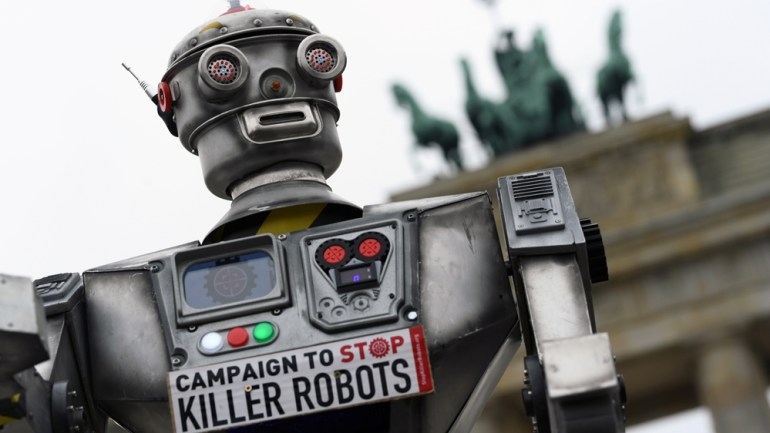 Activists from the Campaign to Stop Killer Robots, a coalition of non-governmental organisations opposing lethal autonomous weapons, stage a protest in Berlin in 2019 [File: Reuters]
Activists from the Campaign to Stop Killer Robots, a coalition of non-governmental organisations opposing lethal autonomous weapons, stage a protest in Berlin in 2019 [File: Reuters]
 Activists from the Campaign to Stop Killer Robots, a coalition of non-governmental organisations opposing lethal autonomous weapons, stage a protest in Berlin in 2019 [File: Reuters]
Activists from the Campaign to Stop Killer Robots, a coalition of non-governmental organisations opposing lethal autonomous weapons, stage a protest in Berlin in 2019 [File: Reuters]Killer robots or loyal wingmen?
While the much-hyped idea of “Killer Robots” – remorseless machines hunting down humans and “terminating” them for some reason known to themselves – has caught the public’s imagination, the current focus of AI could not be further from that.
As a recent report on the military applications of AI points out, the technology is central “to providing robotic assistance on the battlefield, which will enable forces to maintain or expand warfighting capacity without increasing manpower”.
What does this mean? In effect, robotic systems will do tasks considered too menial or too dangerous for human beings – such as unmanned supply convoys, mine clearance or the air-to-air refuelling of aircraft. It is also a “force multiplier”, which means it allows the same amount of people to do and achieve more.
An idea that illustrates this is the concept of the robotic “Loyal Wingman” being developed for the US Air Force. Designed to fly alongside a jet flown by a human pilot, this unmanned jet would fight off the enemy, be able to complete its mission, or help the human pilot do so. It would act as an AI bodyguard, defending the manned aircraft, and is also designed to sacrifice itself if there is a need to do so to save the human pilot.
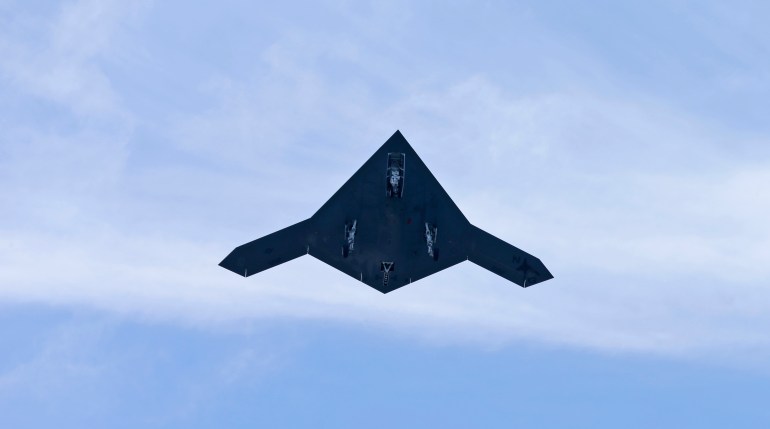 A Navy X-47B drone, an unmanned combat aerial vehicle [File: AP]As AI power develops, the push towards systems becoming autonomous will only increase. Currently, militaries are keen to have a human involved in the decision-making loop. But in wartime, these communication links are potential targets – cut off the head and the body would not be able to think. The majority of drones currently deployed around the world would lose their core functions if the data link connecting them to their human operator were severed.
A Navy X-47B drone, an unmanned combat aerial vehicle [File: AP]As AI power develops, the push towards systems becoming autonomous will only increase. Currently, militaries are keen to have a human involved in the decision-making loop. But in wartime, these communication links are potential targets – cut off the head and the body would not be able to think. The majority of drones currently deployed around the world would lose their core functions if the data link connecting them to their human operator were severed.This is not the case with the high-end, intelligence-gathering, unarmed drone Global Hawk, which, once given “orders” is able to carry them out independently without the need for a vulnerable data link, allowing it to be sent into highly contested airspaces to gather vital information. This makes it far more survivable in a future conflict, and money is now pouring into these new systems that can fly themselves, like France’s Dassault Neuron or Russia’s Sukhoi S70 – both semi-stealthy autonomous combat drone designs.
AI algorithms: More than you
AI programmes and systems are constantly improving, as their quick reactions and data processing allow them to finely hone the tasks they are designed to perform.
Robotic air-to-air refuelling aircraft have a better flight record and are able to keep themselves steady in weather that would leave a human pilot struggling. In war games and dogfight simulations, AI “pilots” are already starting to score significant victories over their human counterparts.
While AI algorithms are great at data-crunching, they have also started to surprise observers in the choices they make.
In 2016, when an AI programme, AlphaGo, took on a human grandmaster and world champion of the famously complex game of Go, it was expected to act methodically, like a machine. What surprised everyone watching was the unexpectedly bold moves it sometimes made, catching its opponent Lee Se-dol off-guard. The algorithm went on to win, to the shock of the tournament’s observers. This kind of breakthrough in AI development had not been expected for years, yet here it was.
Machine intelligence is and will be increasingly incorporated into manned platforms. Ships will now have fewer crew members as the AI programmes will be able to do more. Single pilots will be able to control squadrons of unmanned aircraft that will fly themselves but obey that human’s orders.
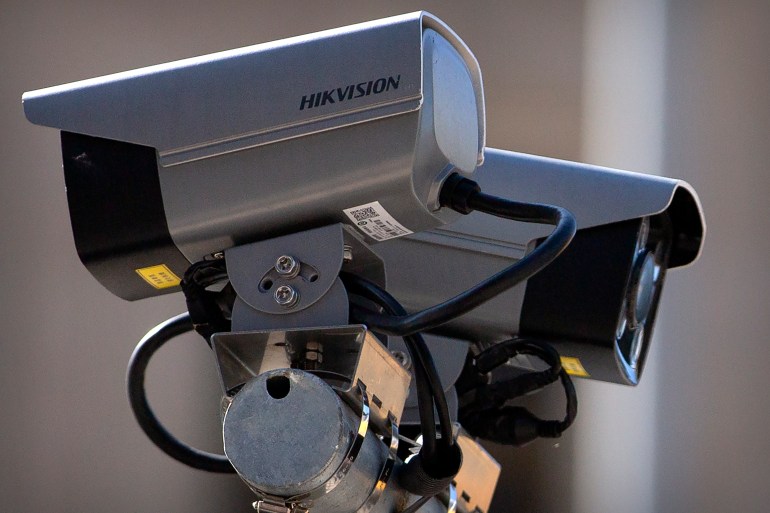 Facial recognition security cameras monitor a pedestrian shopping street in Beijing [File: AP]AI’s main strength is in the arena of surveillance and counterinsurgency: being able to scan images made available from millions of CCTV cameras; being able to follow multiple potential targets; using big data to finesse predictions of a target’s behaviour with ever-greater accuracy. All this is already within the grasp of AI systems that have been set up for this purpose – unblinking eyes that watch, record, and monitor 24 hours a day.
Facial recognition security cameras monitor a pedestrian shopping street in Beijing [File: AP]AI’s main strength is in the arena of surveillance and counterinsurgency: being able to scan images made available from millions of CCTV cameras; being able to follow multiple potential targets; using big data to finesse predictions of a target’s behaviour with ever-greater accuracy. All this is already within the grasp of AI systems that have been set up for this purpose – unblinking eyes that watch, record, and monitor 24 hours a day.The sheer volume of material that can be gathered is staggering and would be beyond the scope of human analysts to watch, absorb and fold into any conclusions they made.
AI is perfect for this and one of the testbeds for this kind of analytical, detection software is in special operations, where there has been a significant success. The tempo of special forces operations in counterinsurgency and counterterrorism has increased dramatically as information from a raid can now be quickly analysed and acted upon, leading to other raids that same night, which leads to more information gathered.
This speed has the ability to knock any armed group off balance as the raids are so frequent and relentless that the only option left is for them to move and hide, suppressing their organisation and rendering it ineffective.
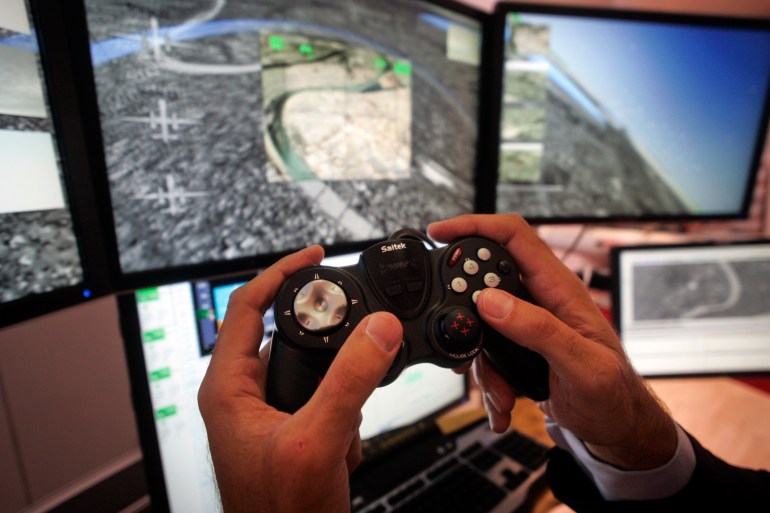 A man uses a PlayStation-style console to manoeuvre the ‘aircraft’, as he demonstrates a control system for unmanned drones [File: AP]As AI military systems mature, their record of success will improve, and this will help overcome another key challenge in the acceptance of informationalised systems by human operators: trust.
A man uses a PlayStation-style console to manoeuvre the ‘aircraft’, as he demonstrates a control system for unmanned drones [File: AP]As AI military systems mature, their record of success will improve, and this will help overcome another key challenge in the acceptance of informationalised systems by human operators: trust.Human soldiers will learn to increasingly rely on smart systems that can think at a faster rate than they can, spotting threats before they do. An AI system is only as good as the information it receives and processes about its environment, in other words, what it “perceives”. The more information it has, the more accurate it will be in its perception, assessment and subsequent actions.
The least complicated environment for a machine to understand is flight. Simple rules, a slim chance of collision, and relatively direct routes to and from its area of operations mean that this is where the first inroads into AI and relatively smart systems have been made. Loitering munitions, designed to search and destroy radar installations, are already operational and have been used in conflicts such as the war between Armenia and Azerbaijan.
Investment and research have also poured into maritime platforms. Operating in a more complex environment with sea life and surface traffic potentially obscuring sensor readings, a major development is in unmanned underwater vehicles (UUVs). Stealthy, near-silent systems, they are virtually undetectable and can stay submerged almost indefinitely.
The dangers
Alongside the advances, there is a growing concern with how deadly these imagined AI systems could be.
Human beings have proven themselves extremely proficient in the ways of slaughter but there is increased worry that these mythical robots would run amuck, and that humans would lose control. This is the central concern among commentators, researchers and potential manufacturers.
But an AI system would not get enraged, feel hatred for its enemy, or decide to take it out on the local population if its AI comrades were destroyed. It could have the Laws of Armed Conflict built into its software.
The most complex and demanding environment is urban combat, where the wars of the near future will increasingly be fought. Conflicts in cities can overwhelm most human beings and it is highly doubtful a machine with a very narrow view of the world would be able to navigate it, let alone fight and prevail without making serious errors of judgement.
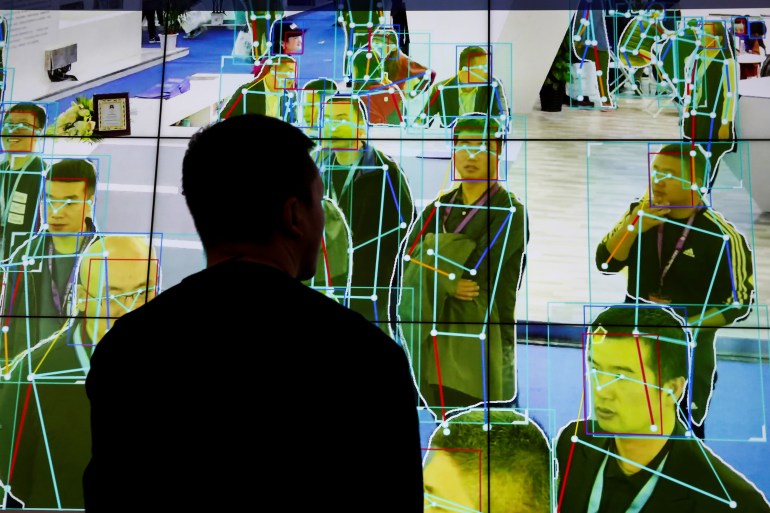 A man looks at a demonstration of human motion analysis software at the stall of an artificial intelligence solutions maker at an exhibition in China [File: Reuters]While they do not exist now, “killer robots” continue to appear as a worry for many and codes of ethics are already being worked on. Could a robot combatant indeed understand and be able to apply the Laws of Armed Conflict? Could it tell friend from foe, and if so, what would its reaction be? This applies especially to militias, soldiers from opposing sides using similar equipment, fighters who do not usually wear a defining uniform, and non-combatants.
A man looks at a demonstration of human motion analysis software at the stall of an artificial intelligence solutions maker at an exhibition in China [File: Reuters]While they do not exist now, “killer robots” continue to appear as a worry for many and codes of ethics are already being worked on. Could a robot combatant indeed understand and be able to apply the Laws of Armed Conflict? Could it tell friend from foe, and if so, what would its reaction be? This applies especially to militias, soldiers from opposing sides using similar equipment, fighters who do not usually wear a defining uniform, and non-combatants.The concern is so high that the Human Rights Watch has urged for the prohibition of fully autonomous AI units capable of making lethal decisions, calling for a ban very much like those in place for mines and chemical and biological weapons.
Another main concern is that a machine can be hacked in ways a human cannot. It might be fighting alongside you one minute but then turn on you the next. Human units have mutinied and changed allegiances before but to turn one’s entire army or fleet against them with a keystroke is a terrifying possibility for military planners. And software can go wrong. A pervasive phrase in modern civilian life is “sorry, the system is down”; imagine this applied to armed machines engaged in battle.
Perhaps the most concerning of all is the offensive use of AI malware. More than 10 years ago, the world’s most famous cyber-weapon Stuxnet sought to insinuate itself into the software controlling the spinning of centrifuges refining uranium in Iran. Able to hide itself, it covered up its tracks, searching for a particular piece of code to attack that would cause the centrifuges to spin out of control and be destroyed. Although highly sophisticated then, it is nothing compared with what is available now and what could be deployed during a conflict.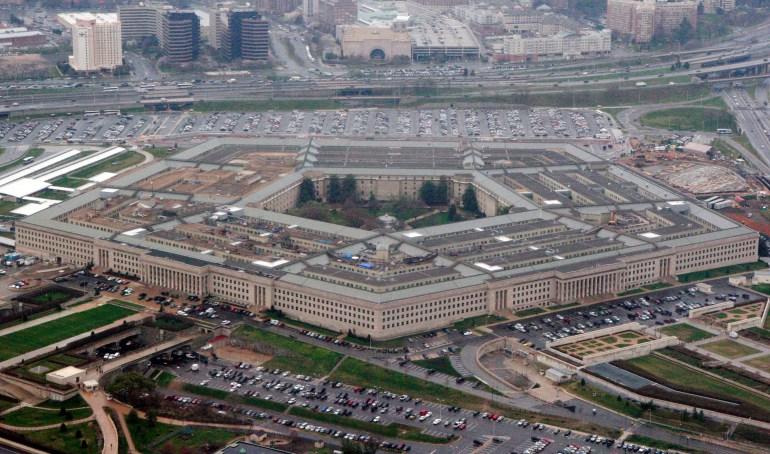 An aerial photo of the Pentagon in Washington, DC; the US military wants to expand its use of artificial intelligence in warfare [File: AP]
An aerial photo of the Pentagon in Washington, DC; the US military wants to expand its use of artificial intelligence in warfare [File: AP]
 An aerial photo of the Pentagon in Washington, DC; the US military wants to expand its use of artificial intelligence in warfare [File: AP]
An aerial photo of the Pentagon in Washington, DC; the US military wants to expand its use of artificial intelligence in warfare [File: AP]Competition: The level playing field
The desire to design and build these new weapons that are expected to tip the balance in future conflicts has triggered an arms race between the US and its near-peer competitors Russia and China.
AI can not only be empowering, it is asymmetric in its leverage, meaning a small country can develop effective AI software without the industrial might needed to research, develop and test a new weapons system. It is a powerful way for a country to leapfrog over the competition, producing potent designs that will give it the edge needed to win a war.
Russia has declared this the new frontier for military research. President Vladimir Putin in an address in 2017 said that whoever became the leader in the sphere of AI would “become the ruler of the world”. To back that up, the same year Russia’s Military-Industrial Committee approved the integration of AI into 30 percent of the country’s armed forces by 2030.
Current realities are different, and so far Russian ventures into this field have proven patchy. The Uran-9 unmanned combat vehicle performed poorly in the urban battlefields of Syria in 2018, often not understanding its surroundings or able to detect potential targets. Despite these setbacks, it was inducted into the Russian military in 2019, a clear sign of the drive in senior Russian military circles to field robotic units with increasing autonomy as they develop in complexity.
China, too, has clearly stated that a major focus of research and development is how to win at “intelligent(ised) warfare”. In a report into China’s embracing of and use of AI in military applications, the Brookings Institution wrote that it “will include command decision making, military deductions … that could change the very mechanisms for victory in future warfare”. Current areas of focus are AI-enabled radar, robotic ships and smarter cruise and hypersonic missiles, all areas of research that other countries are focusing on.
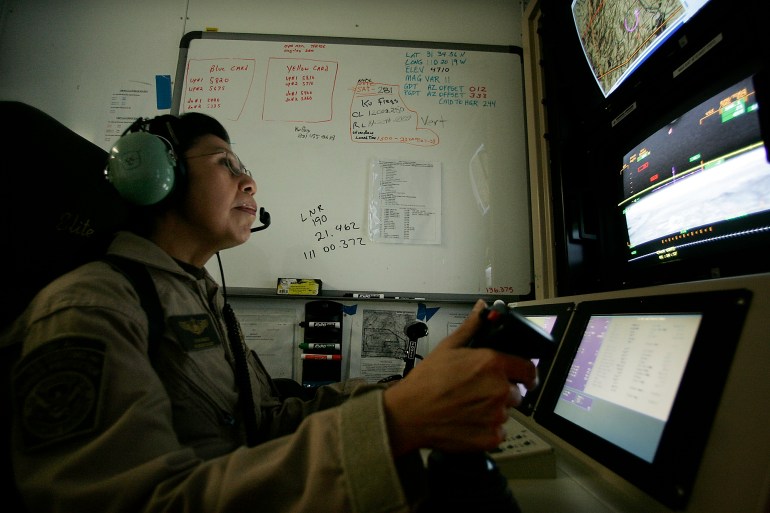 An American military pilot flies a Predator drone from a ground command post during a night border mission [File: AP]The development of military artificial intelligence – giving systems increasing autonomy – gives military planners a tantalising glimpse at victory on the battlefield, but the weapons themselves, and the countermeasures that would be aimed against them in a war of the near future, remain largely untested.
An American military pilot flies a Predator drone from a ground command post during a night border mission [File: AP]The development of military artificial intelligence – giving systems increasing autonomy – gives military planners a tantalising glimpse at victory on the battlefield, but the weapons themselves, and the countermeasures that would be aimed against them in a war of the near future, remain largely untested.Countries like Russia and China with their revamped and streamlined militaries are no longer looking to achieve parity with the US; they are looking to surpass it by researching heavily into the weapons of the future.
Doctrine is key: how these new weapons will integrate into future war plans and how they can be leveraged for their maximum effect on the enemy.
Any quantitative leap in weapons design is always a concern as it gives a country the belief that they could be victorious in battle, thus lowering the threshold for conflict.
As war speeds up even further, it will increasingly be left in the hands of these systems to fight them, to give recommendations, and ultimately, to make the decisions.
No comments:
Post a Comment